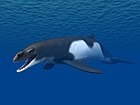Otradnocetus
| Otradnocetus Temporal range: Miocene,
| |
|---|---|
| Scientific classification | |
| Kingdom: | Animalia |
| Phylum: | Chordata |
| Class: | Mammalia |
| Order: | Artiodactyla |
| Infraorder: | Cetacea |
| Parvorder: | Mysticeti |
| Superfamily: | |
| Genus: | †Otradnocetus Mchedlidze, 1984 |
| Species | |
| |
Otradnocetus is an extinct genus of baleen whale from the middle Miocene (late Burdigalian to early Serravallian) of the Russian Caucasus.
Taxonomy[]
Otradnocetus was described by the Georgian paleontologist Guram Mchedlidze in 1984 on the basis of GNM CO 1–90, a partial skeleton including the incomplete skull, mandible, 43 vertebrae and both forelimbs (humeri, radii, ulnae, a few carpals, metacarpals, and phalanges) with scapulae. The type specimen was found in Otradnaya, in the northwestern Russian Caucasus Mchedlidze assigned Otradnocetus to the family Cetotheriidae, at the time a wastebasket for baleen-bearing mysticetes that did belong to any crown-group mysticete group (followed by McKenna and Bell 1997).[1][2] Later recognition of Cetotheriidae sensu McKenna and Bell (1997) as paraphyletic/polyphyletic rendered the systematic position of Otradnocetus, and the cladistic analyses of Gol'din & Steeman (2015) and Gol'din (2018) recovered Otradnocetus as sister to Parietobalaena securis in a clade basal to Cetotheriidae and a clade formed by Pinocetus, Cephalotropis, and Neobalaenidae. The juvenile specimen VSEGEI 2401, referred to Cetotherium aff. mayeri by Riabinin (1934)[3] and also found in the Middle Miocene of the Russian Caucasus, was referred to Otradnocetus by Gol'din (2018).[4][5]
Description[]
Otradnocetus is a medium-size cetothere 4-5 meters in length. It differs from other members of Cetotherioidea and is most similar to Parietobalaena in having a very short ascending process of the maxilla, a short lateral process of the maxilla, an anterior end of nasal located anterior to the rostrum base, and a supraorbital process of the frontal bone directed perpendicular to the anteroposterior axis of the skull. Differences from Parietobalaena include a supraorbital process of the frontal bone not elongated at the lateral end and a robust medially bent coronoid process of the mandible.[5]
References[]
- ^ Mchedlidze GA. 1984. A Fossil whale from the Miocene deposits of environs of Otradnaya. Metsniereba. Tbilisi: Metsniereba [in Russian].
- ^ M. C. McKenna and S. K. Bell. 1997. Classification of Mammals Above the Species Level 1-640.
- ^ Riabinin AI. 1934. New materials on the osteology of Cetotherium mayeri Brandt from the Upper Sarmatian of the Northern Caucasus. Trudy Vsesoyuznogo Geologorazvedochnogo Ob’edineniya SSSR 350:1-15 [in Russian]
- ^ Gol’din P, Steeman ME (2015) From Problem Taxa to Problem Solver: A New Miocene Family, Tranatocetidae, Brings Perspective on Baleen Whale Evolution. PLoS ONE 10(9): e0135500. https://doi.org/10.1371/journal.pone.0135500
- ^ a b Gol'din P. (2018) New Paratethyan dwarf baleen whales mark the origin of cetotheres. PeerJ 6:e5800 https://doi.org/10.7717/peerj.5800
- Miocene cetaceans
- Miocene mammals of Europe
- Miocene genus extinctions
- Prehistoric cetacean genera
- Fossil taxa described in 1984



